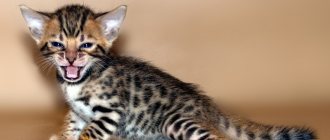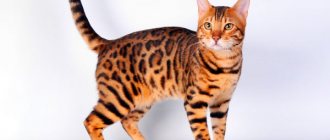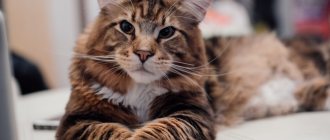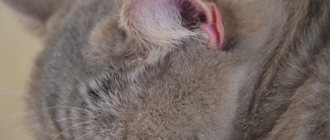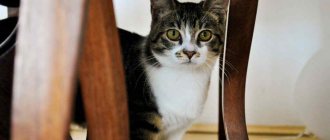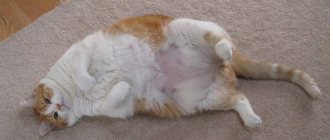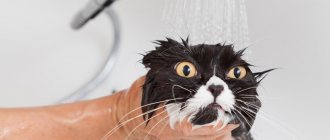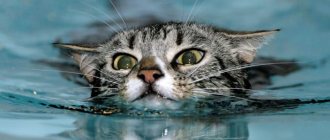What do Bengal cats look like?
Domestic Bengals are a hybrid of wild cats, whose homeland is Asia, and ordinary domestic purrs of different breeds. Their history began in the United States in the 20th century, and now they are popular all over the world.
Bengal cats combine features of wild and domestic cats. Photo: belchonock/Depositphotos
These animals are in many ways reminiscent of their free relatives and look like miniature copies of leopards and other predators. The body of domestic Bengal cats is elongated, muscular and strong, the paws are powerful, and the head is large with expressive eyes and ears that are not very large and rounded at the tips.
The color of these cats varies. The main background is most often golden or silver with a spotted, rosette or dark marble pattern. At the same time, the animals' fur is short, dense, soft, silky and pleasant to the touch.
What is the character of Bengal cats?
Bengals are quite active, curious and playful animals. Moreover, this character manifests itself not only at a young age, but throughout their lives. Therefore, you need to raise a kitten from childhood, so that over time it does not turn into an uncontrollable pet.
Bengal cats are very active and playful. Photo: belchonock/Depositphotos
Animals of this breed are very smart. So, after special training, Bengals can follow simple commands, such as sit, give a paw, and even fetch objects. They are capable of “learning” themselves, so they open cabinet doors and bedside tables without much difficulty.
How do Bengal cats get along with adults?
Such pets are sociable, become attached to people and willingly make contact. They love to be in human society, follow their owner around the apartment with interest and do not ignore everything that happens.
When alone, these cats get bored and are completely sincerely happy when their family members return home. And if you simply ignore your pets for a long time, they will probably remind you of themselves by meowing and will persistently demand attention to their person.
How do Bengal cats get along with children?
Playful and affectionate cats get along well with younger family members and often act as companions in their games. They are not inclined to show aggression and are more likely to retreat if they are not in the mood for communication. Although it is better not to leave them with children who do not yet understand that this is not a living toy in front of them. After all, Bengals can, for example, scratch their young owners, trying to escape from too tight hugs.
How do Bengal cats get along with other animals?
Bengals get along well with dogs.
Photo: pascalegueret / Depositphotos Bengals are natural predators. Therefore, they will not be able to make friends with parrots and hamsters, but will simply perceive them as potential victims. As for dogs and other cats, representatives of this breed get along well with them and practically do not conflict.
What living conditions do Bengal cats require?
Bengals are energetic and active cats that need exercise. To ensure the required level of activity, it is best to install for such an animal a full-fledged play complex with shelves and posts. This way the Bengal cat will be able to splash out its energy and not get bored. Although, even with its own play center, a restless pet will probably explore all the cabinets, bedside tables and shelves in your apartment.
The cat will also definitely appreciate balls, mice and other toys with which you can have fun and frolic. The animal will also need a scratching post that will protect the furniture from its sharp claws.
To diversify your pet’s leisure time, you can take him for walks. It is best to take out a Bengal on a harness so that it does not accidentally run away. You should not let it go unattended: the cat may get lost, be harmed by street animals, or become infected through contact with them.
Take care of your pet's safety. Photo: ingus.kruklitis.gmail.com / Depositphotos
Bengal cats, like other cats, are curious and have a passion for hunting. Therefore, it is advisable to install special grilles on double-glazed windows. This will help protect your pet from falling out of the window while jumping after a flying bird or a falling leaf.
Bengal cat personality
Bengals are very inquisitive, it is important for them to know everything that is happening around them, and it is also advisable to take part in it. They are incredibly active and mobile, love to play with the owner and all family members, as well as with other pets, get along well and are even friends with dogs.
They love heights, and having naturally high agility and jumping ability, they are sure to explore all the shelves, cabinets and other interesting places at heights. To satisfy their need for climbing, it is better to purchase a high play complex with shelves, ladders and posts. It is also better to place the house itself and the resting place at a height, so the cat will feel more comfortable and calm.
From their wild ancestors, Bengal cats also inherited an amazing love for water, especially flowing water. Not all, but many Bengals love to play for a long time with a trickle of water, swim and splash in a basin. They also love watching fish in the aquarium.
Bengal cats and cats are one of the most “talkative” cat breeds. Moreover, this is not a standard classic meow. Their intonations range from a quiet, sometimes whispered “meow” to an angry growl and almost the sound of a siren. These cats definitely need to “yelp” something when you approach, when you pick them up, when the cat itself passes by you. But she will never bore you with her meows, don't worry.
Bengals are renowned for their intelligence and are one of the smartest cat breeds. They perfectly understand human speech and intonation, easily remember the owner’s habits, down to the daily routine, down to the minute. They are quite easy to train and train. They can easily be trained to even fetch a candy wrapper or a toy, like a dog, and accustom them to a harness and leash. They remember their name almost the first time and quickly get accustomed to the tray and scratching post.
Despite their “feline” independence, Bengal cats are very attached to their owner and are able to subtly sense his mood. They clearly understand when it is necessary to approach and cuddle the owner, calming and lifting the mood, and when it is not worth approaching and it is better to wait out the “storm”. Separation from the owner is extremely difficult to bear, and they can start doing mischief out of spite. If you are often away from home for a long time, a Bengal cat will not suit you. The worst punishment for a Bengal is being ignored by the owner and lack of communication.
my beauty Eva
How to feed Bengal cats
It's up to you to decide which diet to choose for your pet. The easiest option is to give your cat ready-made food, which can be wet (canned) or dry. Moreover, it is better to opt for complete products from well-established brands. Such food contains all the necessary microelements, vitamins, carbohydrates, proteins and fats.
You need to choose ready-made food taking into account age: there are separate menus for kittens and adults. There is also special food for sterilized, pregnant and lactating cats, and for those suffering from allergies and other diseases.
Give your pet only high-quality food. Photo: kosmos111 / Depositphotos
In addition, you can feed your pet natural products, including meat, offal, vegetables and more. Such a diet must be thoughtful so that the cat receives everything it needs for health along with its food.
As for regular food from our table, this is not the best option. In addition, some products that are familiar to us are simply dangerous to the health of pets. For example, cats should not be offered fried, salty, spicy or even sweet foods.
Regardless of the diet chosen, the animal must always have access to clean drinking water.
How to care for Bengal cats
The silky and short coat of Bengals needs to be brushed once a week or two using a special brush. If you accustom your pet to this procedure from childhood, it will not cause any special problems.
Caring for the beautiful coat of a Bengal will not cause problems. Photo: Evgenia Stadnikova / Shutterstock
Bengal cats are very clean, so they do not need frequent bathing. Water treatments may be necessary if the pet is very dirty. At the same time, washing Bengals will not cause any special problems. Cats of this breed are calm and even interested in water, play with the streams with pleasure, and some are not even averse to having fun in the bath.
You also need to pay attention to the animal’s claws, even if the cat regularly uses a scratching post. You can trim them at home, but if difficulties arise with the procedure, it is better to contact a veterinary clinic. As for ear hygiene, it is advisable to inspect them at least a couple of times a week and clean them as they become dirty using special lotions or other products.
Care and maintenance
Bengals do not require any special care. The cat should be vaccinated regularly, given anti-parasitic tablets, monitor its diet, play and bathe as needed.
Hygiene
Important! To keep your pet healthy, you should pay attention to caring for the eyes, ears, claws and coat. To do this, remove dirt that has dried in the corners of your cat's eyes every day.
For the procedure, you can use wet baby wipes or a piece of cotton wool soaked in tea leaves or a special zoo lotion. The latter helps to cope with dark spots in the corners of the eyes of snowy and white Bengals.
Bengals do not require special care
Lotions for cats that relieve inflammation and remove ear mites are suitable for cleaning the ears. If the inside of the ear dries out, it is recommended to treat it with baby moisturizer. Brown or gray discharge is a reason to consult a veterinarian.
The Bengal does not need to specially trim or file its claws. The cat constantly wears down the claws on his front paws on a scratching post or rug, and chews on his hind paws.
The cat washes itself several times a day, combing out any loose hairs. This promotes the growth of new fur. Therefore, you should not bathe your pet unless absolutely necessary. But regular brushing improves skin regeneration, removes dirt and matted hairs, preventing the accumulation of hairballs in the animal’s stomach.
They bathe a Bengal cat if it gets dirty or to get rid of parasites. If the pet is sick, bathing is prohibited, as the procedure can provoke the progression of the disease.
The cat washes itself several times a day, combing out any loose hairs.
Diet and feeding
Bengals have a weak digestive system. Therefore, they need special nutrition. There are two types of food - natural or prepared (wet kibble or dry kibble).
Feeding your pet food from a human table is unacceptable. Spices, sweets, fatty and high-calorie foods are harmful to the cat.
Kittens up to 4 months of age are fed six times a day, from 4-6 months - four times, from 6 months to a year - 3 times. For adults, two meals a day is sufficient.
If there is any uneaten meat or prepared wet food left in the bowl, it should be thrown away. After eating a spoiled product, your pet may become poisoned. The exception is ready-made dry food. It can be left for a day.
Be sure to read:
The Ural Rex is a Russian aboriginal breed of curly-haired cat with curly hair.
Education and training
The Bengal cat is a bundle of energy; active games with the owner are important for him. A great option is hide and seek or chasing a rustling candy wrapper tied to a string.
Spending time together will increase mutual affection. Bengals are very sociable. They will be happy to “talk” to the owner.
When raising a kitten, it is worth teaching it the word “no”. To reinforce the prohibition, you can use a squirt gun or water gun.
Life expectancy and typical diseases
When raising a kitten, it is worth teaching it the word “no.”
The maximum age that Bengals live to is 13-16 years. Life expectancy depends on genetics, nutrition and maintenance. Cats of this breed are hardy and healthy.
But they may have genetic diseases - cardiac pathologies, which can cause death. Bengal cats are also susceptible to gastrointestinal infections, poisoning and feline leukemia.
Castration and sterilization
Sterilization and castration is a humane choice for an owner who does not plan to engage in breeding. During the operation, the male's spermatic ducts are tightened or the testicles are removed.
For females, medical, radiation and surgical sterilization is offered. The optimal solution is surgical removal of the animal's uterus and ovaries.
What diseases do Bengal cats suffer from?
Representatives of this breed are strong and hardy animals. But they are also prone to certain diseases. Among them:
- Retinal atrophy (PRA-b) is an inherited disease that eventually leads to complete blindness.
- Hypertrophic cardiomyopathy (HCM) is a heart disease in which the walls of the ventricle thicken, leading to problems with the functioning of the circulatory system.
- Erythrocyte pyruvate kinase deficiency (PK deficiency) is a condition that leads to hemolytic anemia associated with impaired functioning of red blood cells.
- Flat chest syndrome (FCK) is a disease that appears in kittens in the first months of life and can be fatal.
- Dry nose syndrome. It appears in young animals under one year of age, first in the form of crusts and cracks; if neglected, ulcers may appear.
Also, Bengals, like any other cats, can suffer from food and contact allergies, problems with the digestive and genitourinary system, skin diseases and more.
Even a healthy animal needs to be constantly and carefully monitored. If there are any changes in his behavior or suspicious symptoms, it is better to immediately contact a veterinary clinic. This will help you take action in time and avoid bad consequences.
What are nurseries?
Nurseries are breeders who have verified and selected producers: males and females. Such establishments must be registered in felinological systems and clubs. Only a nursery with such registration can guarantee that breed standards are strictly observed and that buyers of kittens receive 100% “Bengalis”.
An important advantage of nurseries is that they make sure that the kittens are genetically healthy. Like all selective breeds, the Bengal cat breed is susceptible to a number of genetic diseases. Therefore, it is important that producers are tested for hereditary diseases. In a trusted nursery, two carriers of mutated genes are never crossed to avoid producing sick offspring. The results of genetic research are simply necessary for the breeder for breeding work. Cats from the cattery always participate in exhibitions and other similar events. If you want to buy an animal that is ready for different shows and accustomed to the public, then there is simply no better place to buy than a nursery.
What to look for when buying a Bengal cat
Before buying a kitten, first decide on your plans for it. If you dream of a show career for your future pet, choose fluffies from the “show” class. Their price is high, but such kittens are potential champions. To breed and obtain high-quality offspring, it is better to focus on the “breed” class. And if you are just looking for a pet for your soul, buy kittens of the “pet” class, the price of which is usually affordable.
Before purchasing, decide on your plans for your pet. Photo: LElik83 / Shutterstock
In addition to prospects, be sure to pay attention to the health of the animal and its appearance. The future pet should be active, mobile and moderately well-fed. He is also required to receive all age-required vaccinations.
When you conclude a deal, make sure that you receive a package of documents along with the kitten: a purchase and sale agreement, a veterinary passport and a metric (cat “birth certificate”), on the basis of which a pedigree is issued.
If you were not given any documents upon purchase, take care of obtaining a veterinary passport and make sure that the kitten is vaccinated. But it will not be possible to draw up a pedigree for such an animal, since it is not known who its parents are.
How to choose a Bengal kitten
Before choosing a Bengal kitten, it is advisable to talk with current owners and visit breed exhibitions. You can also find a responsible breeder there.
To choose the right Bengal kitten, you need to pay attention to:
- for its compliance with the breed standard;
- behavior;
- health.
The mother cat should not be aggressive while examining the litter. She may show dissatisfaction, but under no circumstances try to scratch or bite.
Choosing the right generation
Bengals are a hybrid breed. Its progenitor is the wild Asian leopard cat (ALC). Therefore, before choosing a baby, you need to decide on his generation.
There are 2 main groups:
- Basic Bengals F1 (early generation) - obtained as a result of crossing with ALC.
- SBT Bengals (Stud Book Tradition) are kittens whose parents were purebred Bengals for at least four generations. That is, the wild ancestor is in the fifth and further generations of the pedigree.
- Pet class - purebred babies with serious deficiencies or disqualifying defects. They are not of interest for breeding or exhibition careers. This Bengal can be chosen as a pet. To avoid accidental matings, your pet should be sterilized immediately.
- Breeding class - healthy kittens with excellent pedigree and good appearance. Small defects in the exterior will not allow them to build a brilliant career at exhibitions. But if you choose the right pair, such a cat will produce show-class offspring.
- Show class – elite kittens obtained from producers with high exhibition and breeding ratings. They most fully comply with the breed standard, therefore they have great exhibition prospects. Choosing such a pet is not so easy. Show-class Bengals are often left in nurseries for further work.
- registration number in the stud book;
- name, date of birth, gender, breed and color of the kitten;
- nicknames and colors of parents;
- litter activation date.
The main differences between representatives of different generations lie in character and purpose.
The basic Bengals retained more of the habits of their wild ancestors. Such a pet needs to be taught and trained from early childhood, otherwise it will acquire bad habits and its character will change for the worse.
Choosing an F1 kitten means giving up the opportunity to make a show career. These cats are not allowed to participate in shows and rings. They are usually purchased by breeders to improve the gene pool of the breed or create a new breed line.
To participate in exhibitions you need to choose an SBT Bengali. These kittens are more easily accustomed to the litter tray and scratching post and require less harsh training. If desired, it is easy to teach your pet to walk on a harness and fetch toys on command.
Bengal kitten class
Depending on the severity of breed characteristics and exhibition prospects, all Bengal kittens are conventionally divided into 3 classes:
One litter can have kittens of different classes. A responsible breeder will definitely point out the characteristics of each baby and help you choose a pet suitable for certain purposes.
For your information. Experts rate Bengal cats with large closed rosettes (spots on the body) higher. If the parents have a small pattern, most likely the offspring will be the same.
The cost of a purebred Bengal is 35-50 thousand rubles. For a show-class pet with an almost perfect exterior you will have to pay 100-150 thousand rubles.
Choosing a kitten from an ad on the Internet or at a bird market is not the best idea. Yes, it will cost much less. But no one guarantees that this is a purebred representative of the breed and that he has no health problems.
Pedigree
To select a Bengal kitten, potential owners turn to pedigrees. This is a document about the origin of the animal, which indicates at least three generations of ancestors with information about their titles, breed and color.
For your information. The authenticity of the pedigree is confirmed by the emblem of the felinological system (WCF, TICA, CFA, etc.), the seal and signature of the authorized person of the organization that issued the document.
The kitten may not have a pedigree if the breeder has not yet applied for one. Then the metric serves as confirmation of the baby’s breed. The document must indicate:
Pedigree does not guarantee that a Bengal kitten will have an ideal exterior. Even champion parents sometimes produce rather mediocre offspring. Therefore, you should not rely only on documents. It is better to choose a baby after a personal examination of the litter and consultation with a specialist.
Cat or cat
To choose a boy or girl kitten, the owner needs to understand his own desires and goals:
- Males are often bred for a show career. They are large and muscular, with excellent hair, and look very impressive.
- For breeding it is better to choose a female.
For your information. Keeping an uncastrated stud cat in an apartment is problematic. He will mark his territory, and the pungent smell of cat urine is difficult to remove.
If a person just wants to get a pet, then he can choose any baby. The main thing is that he is healthy.
Outwardly, both male and female cats are equally attractive. There is an opinion that girls are more affectionate and patient, boys are wayward and harmful. However, this is not quite true.
Each Bengal kitten has its own, unique character. Among the females there are cocky individuals, and among the males there are docile and unusually kind cats.
It is possible to study the baby’s disposition in detail only during the process of living together. But it’s not difficult to understand whether he will grow up to be quiet or a bully just by examining him.
Health
Bengal cats have good health. But their weak spot is the digestive system. This breed has a very sensitive gastrointestinal tract, so when fed unsuitable food, they often experience intestinal disorders.
Other typical diseases:
- distal neuropathy is a hereditary nervous disorder characterized by weakness, stiffness of movement, and lack of coordination;
- hip dysplasia is a pathology of the hind limbs that limits the animal’s mobility and leads to lameness;
- degenerative-dystrophic eye diseases - appear more often in old age, reduce visual acuity, and often end in blindness.
When choosing a kitten, you need to make sure the health of its parents. A responsible breeder will provide the results of tests and examinations that confirm that the producers do not have hereditary diseases.
Healthy kittens have clear eyes, clean and shiny fur, and a moderately well-fed constitution. The baby should not have an unpleasant odor or discharge from the eyes or nose. Little Bengals are curious, active and playful.
For your information. On average, Bengal cats live 12-15 years. But among them there are long-livers, stepping over the 20-year mark.
